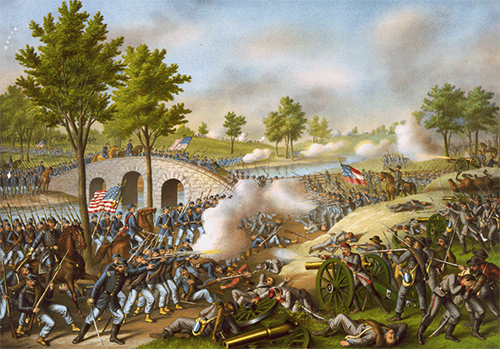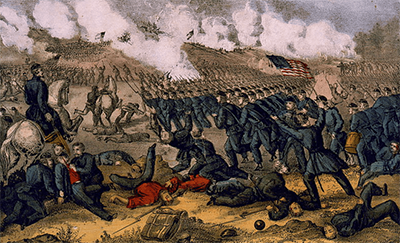Civil War General Ambrose Burnside
Ambrose Burnside was a Union general who had an uneven command record during the American Civil War. He was born on May 23, 1824, in Liberty, Ind. His parents, Edghill and Pamela, had nine children, of which Ambrose was the fourth. They were a Quaker family who opposed slavery and had moved north from South Carolina not long before Ambrose was born. 
Young Ambrose attended Liberty Seminary but stopped after his mother's death to join his father in the family tailor business. In 1843, Ambrose, despite his upbringing in the pacifist Quaker faith, won an appointment to the U.S. Military Academy. He graduated from West Point while the Mexican-American War was finishing up and, commissioned as a second lieutenant, was sent to Vera Cruz but did not see combat. When he returned to the U.S., Burnside served under future Confederate commander but then-Captain Braxton Bragg in the 3rd U.S. Artillery. He served in the West for the better part of four years, then went to Newport, R.I., to serve as commander of Fort Adams. He got married, to Mary Bishop, in 1852 and resigned from the Army the following year. He kept his assignment as a member of the Rhode Island Militia and spent his time working on an improved breech-loading carbine. His weapon won a West Point competition in 1857, he set up the Burnside Arms Company, and he won a contract to supply his guns to the U.S. Army. Burnside then suffered a trifecta of disappointments:
Burnside looked again to the West and found a job with the Illinois Central Railroad, as the treasurer. He found common ground with George McClellan, the former Union top commander and, when the Civil War began, went back to Rhode Island, organized the 1st R.I. Volunteer Infantry, and led it into conflict at the First Battle of Bull Run. Burnside brigade had signed up for the minimum of 90 days, and most of them went home again. Burnside trained other soldiers in the Army of the Potomac and then won appointment as both brigadier general of volunteers and the leader of an expeditionary force headed for North Carolina. He and his men scored victories at New Bern and Roanoke Island, and he won advancement to major general. President Abraham Lincoln offered Burnside command of the Army of the Potomac after McClellan's Peninsula Campaign ended in retreat; Burnside, with a healthy sense of self-awareness, said that he wasn't experienced enough to accept such an assignment, although he had been successful at seizing most of the major ports in North Carolina while McClellan's land-based campaign stalled. After yet another defeat at Bull Run in 1862, Burnside again declined Lincoln's invitation to take over the Army of the Potomac. Instead, he took on leadership of IX Corps, serving under McClellan. 
Burnside led a couple of charges against Robert E. Lee's troops at the Battle of South Mountain, forcing the Confederates off the mountain. Three days later, at the Battle of Antietam, Burnside captured a key bridge but did so slowly enough that he was unable to take advantage of his prize. Burnside did not a third time refuse to head up the Army of the Potomac. On November 7, after Lincoln removed McClellan from command, Burnside agreed to move the army toward Richmond and convinced Lincoln to endorse his plan for a quick strike against Fredericksburg. 
Burnside and his men arrived at the Virginia town before Lee and his men did, but the Union effort bogged down waiting for pontoons so they could cross the Rappahannock River and this delay allowed the Confederate troops to ensconce themselves on Marye's Heights west of town and also on Prospect Hill. Under pressure from Lincoln, Burnside on December 13, 1862, ordered a frontal assault on the heavily fortified Confederate position; the result was extremely heavy casualties (13,000 dead, wounded, captured, or missing) and very little gain (5,000 Confederate dead, wounded, captured, or missing) but no ground seized. Burnside offered his resignation to Lincoln, who refused. A January assault went nowhere because of heavy rains, and Lincoln removed Burnside from the top job on Jan. 26, 1863, reassigning him to head up the Department of the Ohio. One of his more controversial actions there was the issuance of General Order No. 38, which was intended to cut down on anti-war sentiment; one of the more well-known people prosecuted under this order was the well-known lawyer, Congressman, and Democratic Party leader Clement Vallandigham, who was court-martialed and exiled from the U.S. In this new capacity, Burnside commanded troops in defeat the Battle of Chickamauga, prevented a Confederate takeover of Knoxville, and then played a critical role in the Union victory at Chattanooga. He was recalled to the Eastern Theater and served at the Wilderness, Spotsylvania, Cold Harbor, and Petersburg; at the latter, he was responsible for the attack that failed miserably during the Battle of the Crater and was relieved of his command. Burnside left the army on April 15, 1865; he did not return, instead working in the railroad industry for a time. He was thrice elected Governor of Rhode Island and then twice elected to the U.S. Senate. He died on Sept. 13, 1881. Notes:
|
|
Social Studies for Kids
copyright 2002–2025
David White




